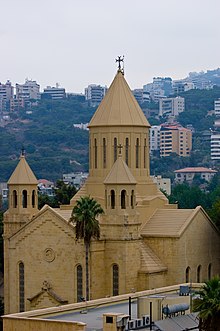Holy See of Cilicia
| Catholicosate of the Great House of Cilicia (Holy See of Cilicia) |
|
|---|---|

The coat of arms of the Catholicosate of the Great House of Cilicia
|
|
| Founder | The Apostles Bartholomew and Thaddeus |
| Independence | Apostolic Era |
| Recognition | Armenian Apostolic Church |
| Primate | Catholicos of the Great House of Cilicia, Aram I. |
| Headquarters | Antelias, Lebanon previously Sis, Turkey |
| Territory | Cilicia & Western Armenia |
| Possessions | Middle East, Europe, North America, South America, Oceania, and Africa. |
| Language | Armenian |
| Members | 4,000,000 |
| Website | Armenian Catholicosate of the Great House of Cilicia |
| Saint Gregory the Illuminator Cathedral Սուրբ Գրիգոր Լուսաւորիչ մայր տաճար |
|
|---|---|

Saint Gregory the Illuminator Cathedral in the Armenian Catholicosate of Cilicia
|
|
| Basic information | |
| Location |
Antelias, |
| Geographic coordinates | 33°55′06″N 35°35′07″E / 33.918275°N 35.585328°ECoordinates: 33°55′06″N 35°35′07″E / 33.918275°N 35.585328°E |
| Affiliation | Armenian Apostolic Church |
| Rite | Armenian Apostolic Rite |
| Municipality | Antelias |
| District | Matn District |
| Province | Mount Lebanon |
| Region | Lebanon |
| Year consecrated | 1930 |
| Ecclesiastical or organizational status | Catholicosate, Church Headquarters, Cathedral |
| Status | Active |
| Leadership | His Holiness Catholicos Aram I |
| Website | http://www.armenianorthodoxchurch.org/ |
| Architectural description | |
| Architectural style | Armenian |
| Completed | 1930 |
The Armenian Catholicosate of the Great House of Cilicia (Armenian: Կաթողիկոսութիւն Հայոց Մեծի Տանն Կիլիկիոյ) is a hierarchal see of the Armenian Apostolic Church. Since 1930, the Catholicosate of the Great House of Cilicia has been headquartered in Antelias, Lebanon. Aram I is the Catholicos of Cilicia of the Armenian Apostolic Church since 1995.
The origin of the Armenian Church dates back to the Apostolic age and according to the ancient tradition was established by St. Thaddeus and St. Bartholomew. In 301 AD, Christianity was officially accepted by the Armenians as the state religion.
St. Gregory the Illuminator, the patron Saint of the Armenian Apostolic Church, and King Tiridates III of Armenia, the ruler of the time, played a pivotal role in the official Christianization of Armenia. St. Gregory the Illuminator became the organizer of the Armenian Church hierarchy. From that time, the heads of the Armenian Church have been called Catholicos and still hold the same title. St. Gregory chose as the site of the Catholicosate then the capital city of Vagharshapat, in Armenia. He built the pontifical residence next to the church called "Holy Mother of God" (which in recent times would take on the name of Holy Etchmiadzin).
In 485 AD, the Catholicosate was transferred to the new capital Dvin. In the 10th century it moved from Dvin to Dzoravank and then to Aghtamar (927 AD), to Arghina (947 AD) and to Ani (992 AD).
After the fall of Ani and the Armenian Kingdom of Bagradits in 1045, masses of Armenians migrated to Cilicia. The Catholicosate, together with the people, settled there. The seat of the church (now known as The Catholicosate of the Great House of Cilicia) was first established in Sivas (1058 AD) moving to Tavbloor (1062 AD), then to Dzamendav (1066 AD), Dzovk (1116 AD), Hromgla (1149 AD), and finally in Sis (1293), the capital of the Cilician Kingdom.
...
Wikipedia

